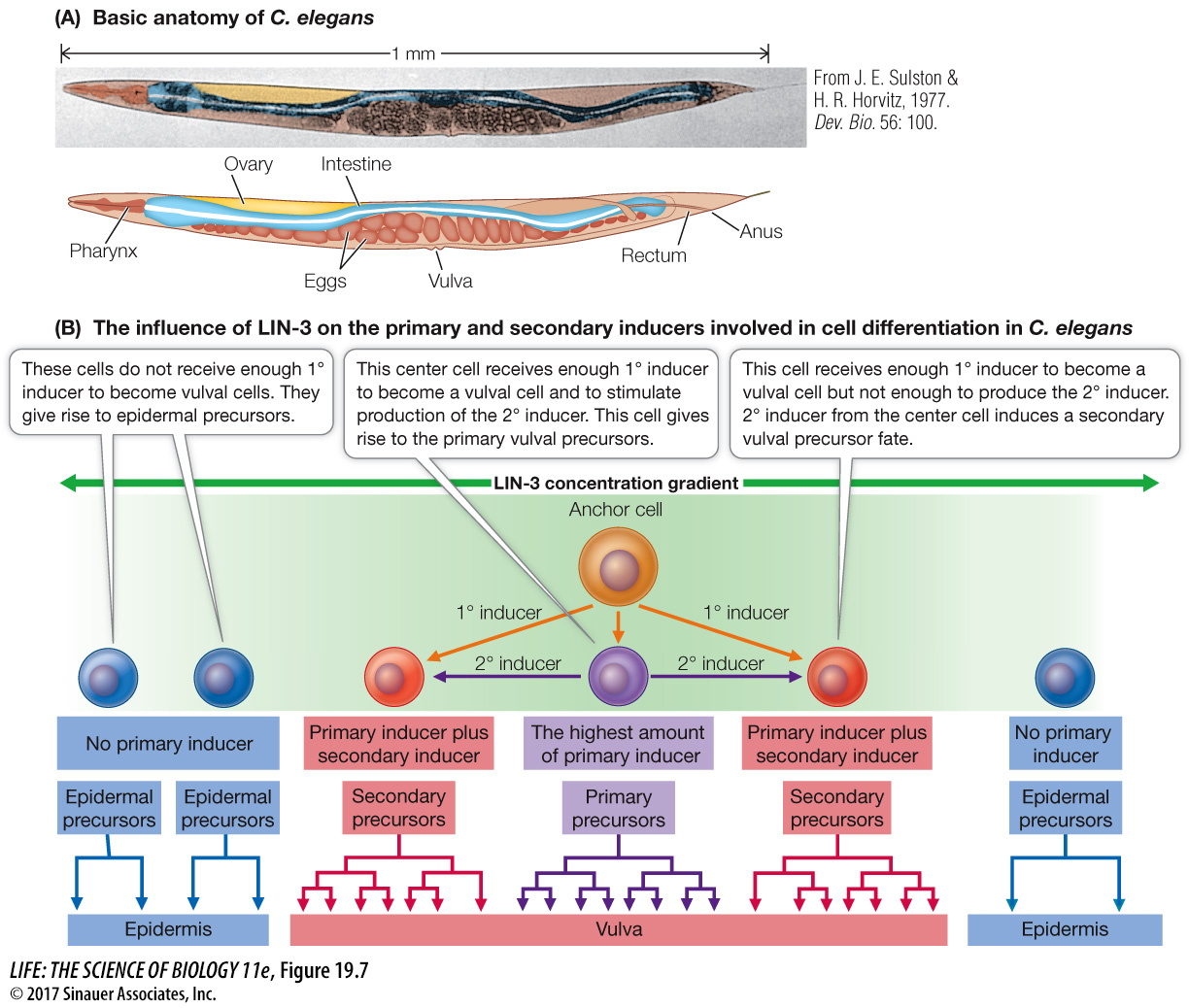Inducers passing from one cell to another can determine cell fate
The term “induction” has different meanings in different contexts. In biology it can be used broadly to refer to the initiation of, or cause of, a change or process. But in the context of cellular differentiation, it refers to the signaling events by which cells in a developing organism communicate and influence one another’s developmental fate. Induction involves chemical signals and signal transduction mechanisms. An example of embryonic induction occurs during the development of a reproductive structure of the nematode Caenorhabditis elegans.
Caenorhabditis elegans develops from fertilized egg to larva in only about 12 hours, and the worm reaches the adult stage in just 3.5 days. The process is easily observed using a low-magnification dissecting microscope because the body covering is transparent (Figure 19.7A). Most adult nematodes are hermaphroditic, containing both male and female reproductive organs. They lay eggs through a pore called the vulva on the ventral (lower) surface. During development, a single cell in the overlying gonad, called the anchor cell, induces the vulva to form from six cells on a worm’s ventral surface (Figure 19.7B). In this case there are two molecular signals: the primary (1°) inducer and the secondary (2°) inducer. Each of the six ventral cells has three possible fates: it may become a primary vulval precursor cell, a secondary vulval precursor cell, or simply become part of the worm’s skin—an epidermal cell. You can follow the sequence of events in Figure 19.7B. The concentration gradient of the primary inducer, LIN-3, is key. (LIN stands for abnormal cell lineage.) The anchor cell produces the LIN-3 protein, which diffuses out of the cell and forms a concentration gradient with respect to adjacent cells. Three cells receive more LIN-3 than the others and become vulval precursor cells; cells farther from the anchor cell receive less LIN-3 and become epidermal cells. The cell closest to the anchor cell receives the most LIN-3—enough LIN-3 to trigger a signal transduction response in the closest neighboring cell that results in the expression of the secondary inducer. The secondary inducer then acts on the two adjacent cells. This second induction event results in the two classes of vulval precursor cells: primary and secondary.

Figure 19.7 Induction during Vulval Development in Caenorhabditis elegans (A) In the nematode C. elegans (shown in false color here), it is possible to follow all of the cell divisions from the fertilized egg to the 959 somatic cells found in the adult. (B) During vulval development, a molecule secreted by the anchor cell (the LIN-3 protein) acts as the primary (1°) inducer. The primary precursor cell (the one that receives the highest concentration of LIN-3) then secretes a secondary (2°) inducer that acts on its neighbors. The gene expression patterns triggered by these molecular switches determine cell fates.
Induction involves the activation or inactivation of specific sets of genes through signal transduction cascades in the responding cells. When an inducer binds to its specific receptor on the surface of a cell, a signal transduction pathway leads to the activation of one or more transcription factors. Recall from Key Concept 16.2 that these DNA-binding proteins regulate the expression of specific genes. You can follow this process in Focus: Key Figure 19.8 where the cell on the left is exposed to a high concentration of inducer. The inducer activates a transcription factor in the cytoplasm, which enters the nucleus to switch on the expression of a specific gene. The cell on the right is exposed to a lower concentration of the inducer, and as a result, gene expression is not activated.
focus: key figure

Figure 19.8 Induction The concentration of an inducer directly affects the degree to which a transcription factor is activated. The inducer acts by binding to a receptor on the target cell. This binding is followed by signal transduction involving transcription factor activation or translocation from the cytoplasm to the nucleus. In the nucleus it acts to stimulate the expression of genes involved in cell differentiation.
Question
Q: Could differential expression of receptor genes result in differential gene expression through induction?
Yes, If the cell on the right of the figure had fewer receptors but the same exposure to inducer, it might have less activation of transcription.

